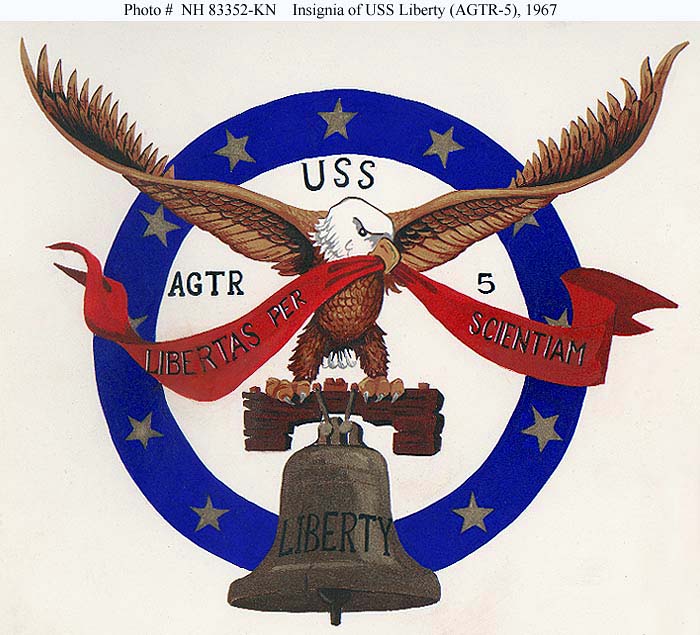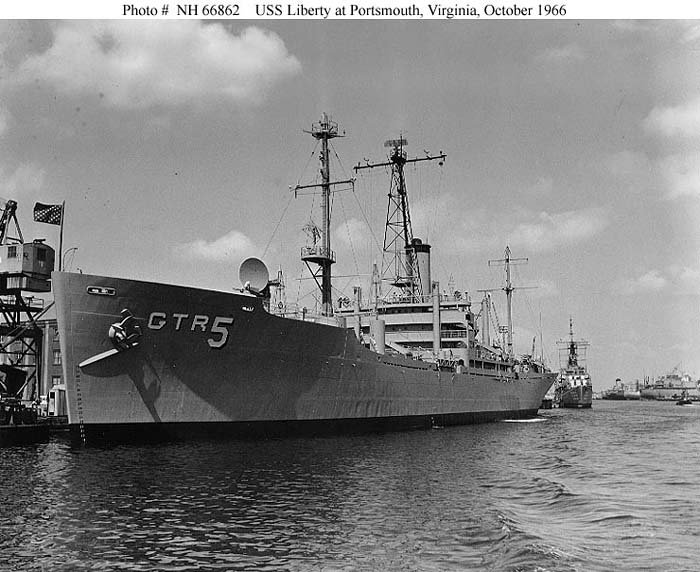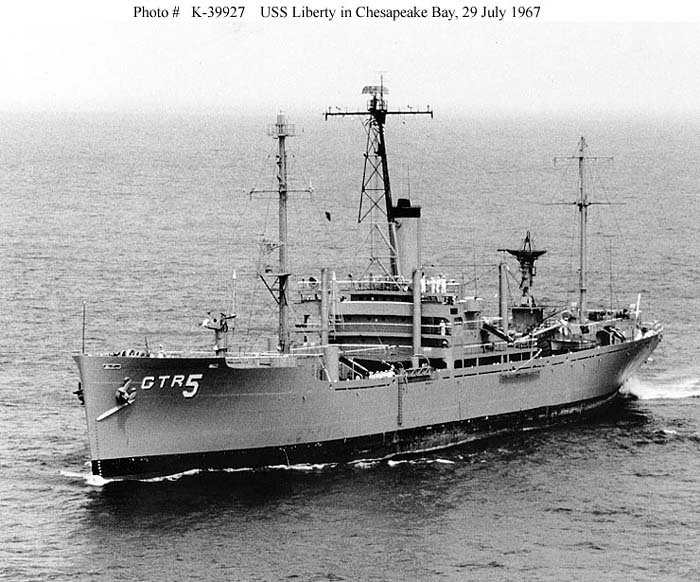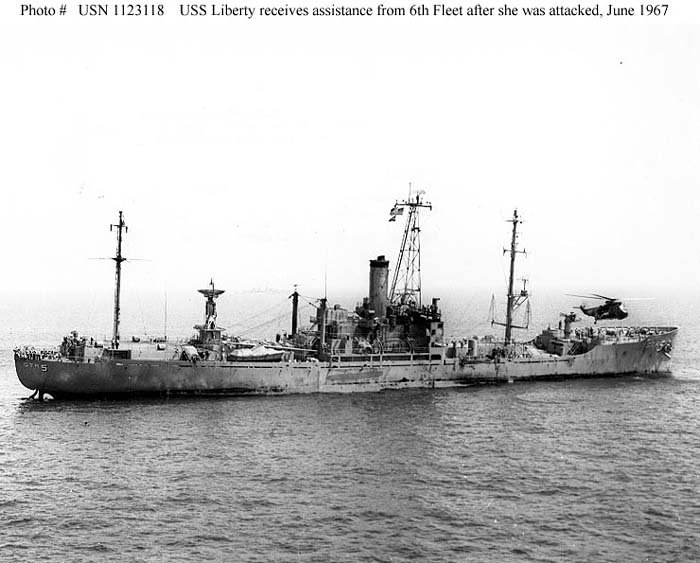ISRAEL MAKES UNPROVOKED ATTACK
ON U.S. NAVY SHIP - Page 1
The USS Liberty is attacked by Israel with aircraft and torpedoes.

Israel Makes Unprovoked Attack on
U.S. Navy Ship
The USS LIBERTY is attacked by Israel with aircraft and torpedo
boats
Killing 34 and wounding 173. The dispute continues to this
day.

USS LIBERTY GTR-5
Ctsy: U.S. Navy
The USS Liberty incident was an attack on a U.S. Navy signals intelligence ship, USS Liberty, in international waters about 12.5 nautical miles from the coast of the Sinai Peninsula, north of the Egyptian town of El Arish, by Israeli fighter planes and torpedo boats on June 8, 1967.
It occurred during the Six-Day War, a conflict between Israel and the Arab states of Egypt, Jordan, Syria and Iraq. The Israeli attack killed 34 U.S. servicemen and wounded at least 173. The attack was the second-deadliest against a U.S. warship since the end of World War II, surpassed only by the Iraqi Exocet missile attack on the USS Stark on May 17, 1987, and marked the single greatest loss of life by the U.S. intelligence community.

USS LIBERTY in Cheasapeake Bay
Ctsy: U.S. Navy
The Israeli and American governments conducted multiple inquiries into the incident, and issued reports concluding that the attack was the result of a mistake, caused by confusion among the Israeli attackers about the precise identity of the USS Liberty. These conclusions have been challenged, most notably by an organization of Liberty survivors as well as by some key former high-ranking U.S. officials who were in office at the time. These skeptics have included Secretary of State Dean Rusk, the Chairman of the Joint Chiefs of Staff, the Director of the NSA, and the senior legal counsel to the U.S. Navy Court of Inquiry into the incident. While the matter is officially closed for purposes of Israeli-American relations, it remains controversial in public discussion.
Israel's official position is that the attack was not the result of an intentional targeting of an American ship. Israeli officials say they were assured by the United States that no U.S. ships were in the area, and that its air and naval forces mistakenly identified Liberty as the Egyptian vessel El Quseir. Supporters of this position say Israel had no motive for a surprise attack on an important ally. They also note that the tense atmosphere of the Six-Day War created the possibility of such mistakes, and point out that the U.S. government, concerned about such dangers, ordered the Liberty further away from shore (although the Liberty — despite being an NSA electronics signals listening ship with extensive communications equipment — claims that communications failures kept the order from arriving in time). Finally, they note that the United States has several times mistakenly attacked its own and allied forces in so-called friendly fire incidents.
Others claim that the attack was deliberate and premeditated. They note that the Liberty was more than twice as large as the El Quseir, and was clearly designated with Latin rather than Arabic letters and numbers. Proponents include surviving Liberty crewmen, and some former U.S. government officials, including then-CIA director Richard Helms and then-Secretary of State Dean Rusk as well as Admiral Thomas Hinman Moorer, former Chief of Naval Operations and Chairman of the Joint Chiefs of Staff.
On December 17, 1987, the issue was officially closed by the two governments through an exchange of diplomatic notes. Israel also eventually paid nearly $13 million in humanitarian reparations to the United States and in compensation to the families of the victims.
The attack on the Liberty

USS LIBERTY AFTER ATTACK
Ctsy: U.S. Navy
USS Liberty was originally the 7,725-ton (light) civilian cargo ship Simmons Victory (a Victory Ship, the follow-on series to the famous Liberty Ships). She was acquired by the United States Navy, converted to an Auxiliary Technical Research Ship (AGTR), and began her first deployment in 1965 , to waters off the west coast of Africa. She carried out several more operations during the next two years. During the Six-Day War between Israel and the Arab nations, she was sent to collect electronic intelligence in the eastern Mediterranean.
On June 4, 1967, the day before the start of the Six-Day War, Israel asked if the United States had any ships in the region. The U.S. said it did not, and United States Ambassador Goldberg announced in the United Nations that the U.S. had no ships within 350 - 400 miles, despite Arab complaints that the U.S. and British were supporting Israel in the conflict. At the time the statement was made, this was the case, since the Liberty was just entering the Mediterranean Sea but would ultimately steam to within a few miles of the Sinai Pensinsula.
Numerous messages were sent by the U.S. Navy to the Liberty, repeatedly changing its operational area, variously ordering the Liberty 33 miles away from the conflict and at others as close as 6.5 miles from Israel. On the night of June 7 Washington time, early morning on June 8, the Pentagon issued an order to Sixth Fleet headquarters to tell the Liberty to come no closer than 100 nautical miles (185 km) to Israel, Syria, or the Sinai coast By the time that warning was sent, the Liberty was already cruising 10-12 miles off the coast of Israel and the Sinai. However, due to a long series of administrative and communications problems, the message to withdraw was not transmitted on the frequency Liberty monitored for orders until after the attack.
| next page >> |